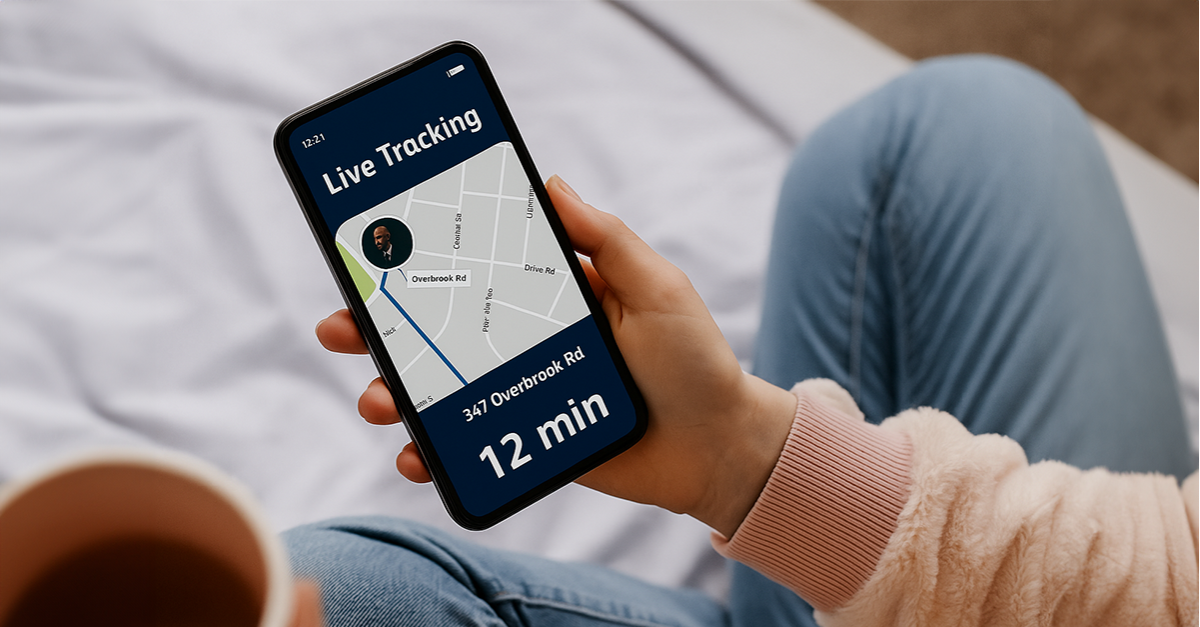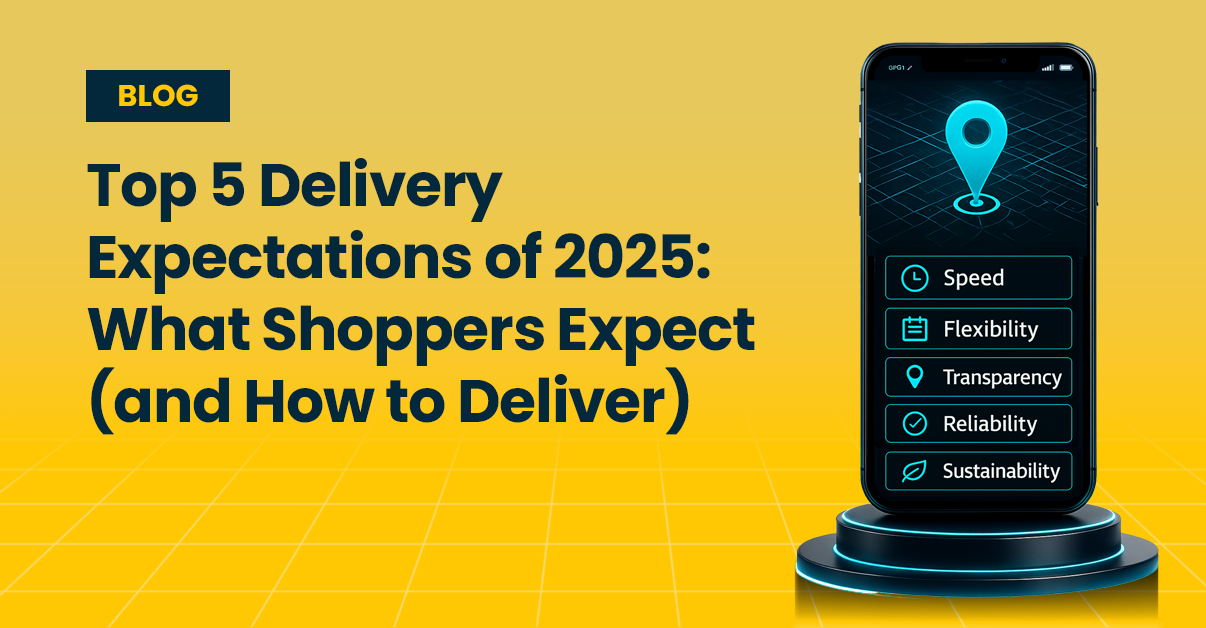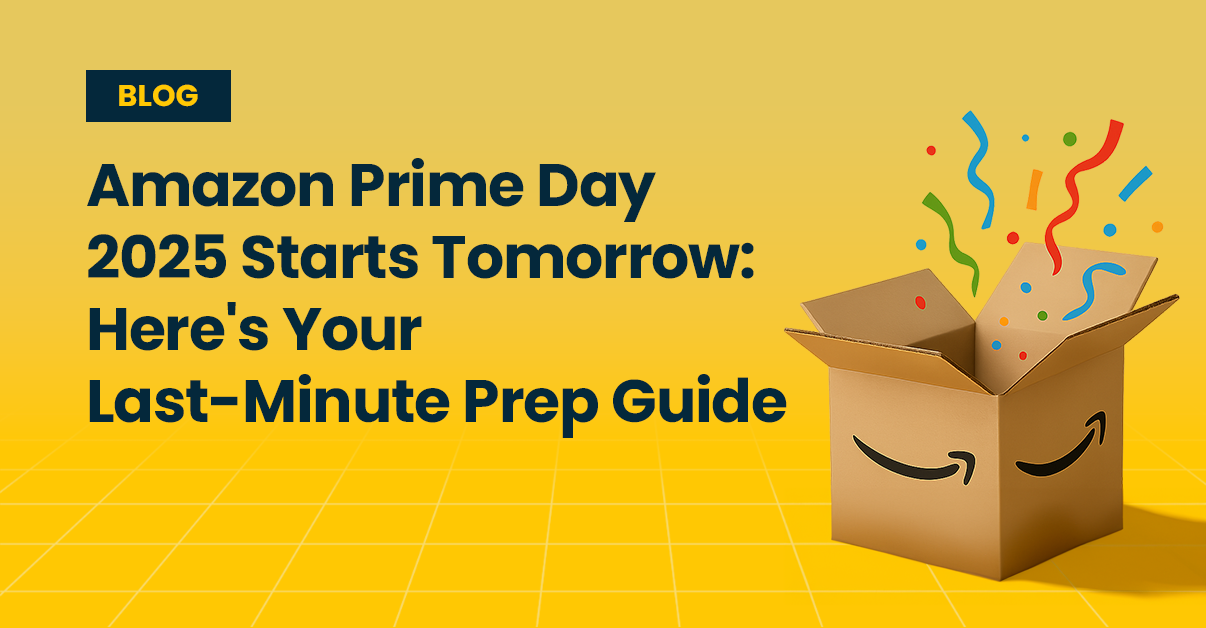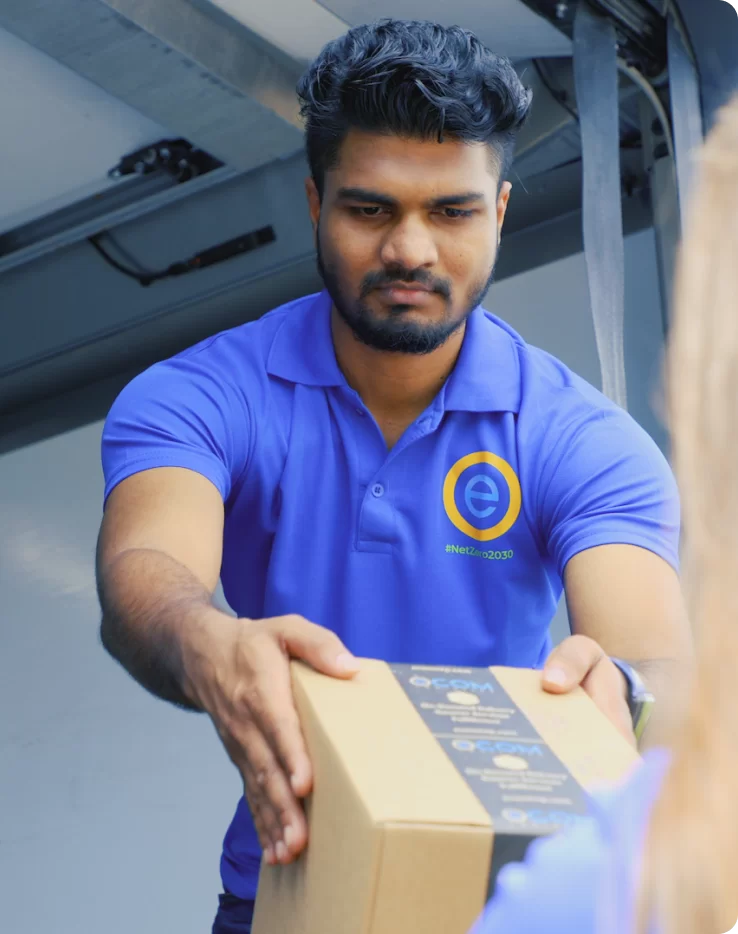The e-commerce landscape has transformed beyond recognition. What once impressed customers, getting their order within a week, now feels glacially slow. Today’s consumers don’t just want fast delivery; they demand transparency, flexibility, and sustainability as standard features, not premium add-ons.
For e-commerce businesses, understanding these evolved expectations isn’t optional, it’s survival. With global e-commerce sales projecting to reach 8 trillion by 2027 and competition fiercer than ever, your delivery experience often determines whether a customer becomes a loyal advocate or switches to a competitor with a single click.
This article breaks down the five non-negotiable delivery expectations shaping 2025, and shows you exactly how to meet them.

Expectation #1: Fast shipping is now the baseline
Gone are the days when “fast shipping” meant anything longer than 48 hours. Today’s consumers have reset their clocks entirely.
The numbers are stark: 74% of online shoppers expect delivery within two days, while 56% of online shoppers between ages 18-34 expect same-day delivery. Even more telling, 63% of consumers choose a different retailer for later purchases if shipping takes longer than two days.
The generational divide tells an even more compelling story:
- 49% of Millennials expect free two-day delivery services; 40% expect free same-day delivery
- 40% of Generation X expects free two-day delivery; 27% expect same-day delivery
- 35% of Generation Z expects free two-day delivery; 18% expect free same-day delivery
But here’s what many retailers miss: speed isn’t just about convenience, it directly impacts your bottom line. Half of shoppers are more likely to shop online if offered same-day delivery, and 69% of consumers say one-day delivery is the best incentive to shop online.
The conversion impact is immediate. When shipping options don’t meet expectations, customers don’t just complain, they abandon their carts entirely. This creates a direct correlation between delivery speed and revenue that ecommerce businesses can no longer ignore.
Expectation #2: Personalized and flexible delivery options
The one-size-fits-all approach to delivery died in 2024. Today’s consumers expect delivery options that adapt to their unique lifestyles, preferences, and schedules—but they also want reliability above all else.
Recent research reveals a fascinating shift in priorities. While speed captures headlines, reliability and flexibility often determine long-term customer loyalty. Consumer priorities have shifted over the past few years, with a significant number of customers revealing flexible delivery options as more important to their satisfaction than speedy delivery.
Some of the most valued flexibility features include:
- The ability to make last minute changes in delivery instructions
- Reliable doorstep drop-offs that minimize missed deliveries
The business case for personalization is compelling. 62% of consumers under 35 value their shopping experience as a whole and won’t hesitate to switch brands if their expectations aren’t met. For e-commerce businesses, this translates to fewer failed deliveries, reduced customer service inquiries, and higher satisfaction scores.
Expectation #3: Real-time tracking is a must
Transparency isn’t a nice-to-have feature, it’s become the foundation of customer trust in 2025.
The statistics are unequivocal: 92% of consumers consider delivery windows when choosing to buy; 88% find real-time delivery tracking critical for a positive customer experience. Perhaps most importantly, 11% of consumers reported that real-time tracking and proactive updates are the most important aspects of online shopping.
The tracking features that build genuine customer confidence include:
- Live tracking maps that show exactly where packages are
- Accurate ETAs that update based on real-time conditions
- Proactive notifications for delays, delivery attempts, and successful deliveries
- Multiple communication channels (SMS, email, app notifications)
The loyalty impact is measurable. About 50% of respondents say they track the status of orders to ensure that the shipment is progressing and remains on time. When tracking falls short, customers notice immediately, and remember for future purchases.
Here’s the critical insight for ecommerce businesses: customers don’t just want to know where their package is; they want to feel in control of the delivery process. Real-time tracking transforms anxiety into anticipation, turning delivery day from a source of stress into a positive brand touchpoint.

Expectation #4: Final-mile assurance is non-negotiable
Tracking a package is one thing, knowing it arrived safely is another. In 2025, customers expect more than just an “Out for delivery” or “Delivered” status. They want clear, verifiable confirmation that their order made it to the right place, at the right time. That’s where final-mile assurance comes in.
With the rise of package theft, missed deliveries, and growing consumer expectations, proof of delivery (POD) has become a must-have feature—not just for peace of mind, but for building trust and loyalty.
Why it matters
Final-mile confirmation reduces uncertainty, cuts customer service tickets, and helps businesses resolve issues faster. Studies show that:
- Proof of delivery can reduce delivery errors by up to 50%
- Businesses using visual delivery confirmation report 30% higher customer satisfaction
- Clear, verified delivery records help reduce false “not delivered” claims and prevent disputes that lead to chargebacks
Customers aren’t just asking, “Where’s my package?” anymore, they’re asking, “Can you prove it got here?” This kind of visibility makes the difference between uncertainty and trust, and for e-commerce brands, that trust translates to stronger retention and fewer escalations.
A strong POD system isn’t just about compliance, it’s about protecting your revenue and reputation. Visual confirmation and clear records resolve customer concerns quickly, reduce operational strain, and reinforce your commitment to delivering with care. It’s the final touchpoint in the delivery journey, and one of the most important.
Expectation #5: Sustainability is no longer optional
Environmental consciousness has moved from a nice-to-have to a deal-breaker for many consumers. In 2025, sustainable delivery practices aren’t just about corporate responsibility, they’re about competitive advantage.
Going green with deliveries starts by choosing partners who prioritize sustainability at every step. Here’s how to make a meaningful impact:
- Electric vehicles and optimized routes: Smart logistics that reduce carbon footprints while maintaining delivery speed appeal to environmentally conscious consumers.
- Green shipping options: Many customers are willing to wait slightly longer for deliveries that use sustainable transportation methods or packaging.
- Consolidated deliveries: Combining multiple orders into single trips reduces environmental impact while often providing cost savings that can be passed to customers.
The business impact extends beyond customer satisfaction. Supply chain optimization: Robotics and automation are revolutionizing warehousing, as technologies like AI, automation, and drones will hone delivery and last-mile operations for retailers. Sustainable practices often align with operational efficiencies that reduce costs while improving delivery performance.
For ecommerce businesses, this represents an opportunity to differentiate while building long-term customer relationships with environmentally conscious consumers who tend to demonstrate higher lifetime value.

Why the right last-mile partner matters
Delivery isn’t just the final step in your customer’s journey, it’s often the most memorable one. Whether that memory is positive or negative can make or break customer loyalty and directly impact your business growth.
Here’s the reality: you can have the best product, the most compelling marketing, and the smoothest online checkout experience, but if delivery fails, customers remember that failure more than everything that went right.
When evaluating last-mile delivery partners, e-commerce businesses should prioritize:
- Speed and reliability: Look for partners with proven track records of meeting delivery promises. Delivery convenience has a much greater impact on customer loyalty than branding according to peer-reviewed studies.
- Real-time tracking and communication: Your partner should provide the transparency customers demand, with robust tracking systems and proactive communication throughout the delivery process.
- Scalable and sustainable infrastructure: As your business grows, your delivery partner should scale with you while maintaining the sustainable practices that modern consumers expect.
- Geographic coverage: Make sure your partner can serve your entire target market effectively, including urban centers and more remote locations.
- Technology integration: Seamless integration with your e-commerce platform ensures smooth information flow and consistent customer experiences.
This is where specialized last-mile providers like Ecom Express and Ecom Standard make the difference. With dedicated focus on e-commerce delivery challenges, we understand the unique needs of online retailers and the evolving expectations of digital consumers.
Ecom delivers more than parcels, we deliver a competitive edge. As one of Canada’s leading last-mile delivery solutions for e-commerce, we empower businesses with:
- Same-day and next-day delivery to major canadian cities: Need it there fast? We’ve got you. With same-day and next-day delivery options across major Canadian cities, we help you meet your customers’ expectations without breaking a sweat, even during peak seasons.
- Flexible delivery options like doorstep drop-offs: Everyone’s day looks different, so we give your customers choices. Whether they want it at their door or at a nearby pickup point, we make delivery work for their convenience, not the other way around.
- Live tracking and real-time notifications: No more “where’s my package?” texts. We keep your customers in the loop with real-time tracking and proactive updates at every stage of the delivery. It’s transparency that builds trust, and keeps support calls down.
- Sustainable EV fleet that doesn’t compromise on speed: Fast and eco-friendly? Yep. Our electric delivery vehicles help reduce emissions while still keeping things quick and efficient. It’s a great way to support your sustainability goals, and show your customers you walk the talk.
- Smart routing with advanced tech: We use smart tech to make your deliveries smarter. With optimized routes, we cut out delays and wasted time, so your packages arrive faster, and your logistics run leaner.
- Seamless tech integrations: We play nice with your existing systems. Whether it’s Shopify, WooCommerce, or your own setup, our integrations keep everything running smoothly, from order flow to delivery confirmation, so you don’t have to worry about tech headaches.
- A smarter, more interactive tracking experience: We’ve taken tracking to the next level. Your customers can leave instructions, change delivery details, get instant updates, or even chat with support, right from the tracking page. It’s delivery that adapts to their needs in real time.
Whether you’re scaling up, enhancing your customer experience, or building a greener brand, we are ready to help you deliver smarter in 2025.
The bottom line: Adapt or fall behind
The delivery expectations bar isn’t just higher in 2025, it’s constantly rising. Global ecommerce sales will account for $6.86 trillion in 2025, which is an 8.37% increase from 2024, and with that growth comes intensified competition for customer attention and loyalty.
The brands that will thrive are those that recognize delivery as a strategic advantage, not just a logistical necessity. They understand that meeting customer expectations around speed, reliability, transparency, personalization, and sustainability isn’t optional, it’s the minimum entry point for competing in today’s market.
E-commerce businesses have a choice: invest in delivery experiences that match customer expectations, or watch those customers migrate to competitors who will. The data is clear, the expectations are set, and the opportunity is immediate.
The customers have spoken. The question is: are you ready to deliver?
If fast, flexible, and sustainable delivery isn’t part of your strategy yet, it’s time. Ecom Express is here to help you turn delivery into one of your biggest brand wins. From same-day and next-day shipping to real-time tracking and EV-powered routes, we make last-mile logistics simple, smart, and customer-first. Contact us to know more
Frequently asked questions
1. Why are customers abandoning their carts due to delivery options?
Customers expect fast, flexible, and transparent delivery. If they don’t see options like same-day shipping, real-time tracking, or clear return policies at checkout, they lose confidence. Many will abandon their carts, knowing a competitor likely offers a better experience. Meeting expectations upfront improves conversion and loyalty.
2. How can smaller e-commerce businesses afford to offer same-day or next-day delivery?
Partnering with the right last-mile provider makes all the difference. Providers like Ecom Express offer scalable solutions, optimized routing, and shared delivery networks that reduce individual shipping costs, helping smaller businesses offer faster delivery without building infrastructure from scratch.
3. What role does delivery personalization play in customer satisfaction?
A lot. Today’s shoppers want to choose when, where, and how their order arrives. Whether it’s evening delivery, secure drop-off points, or consolidated shipments, personalized delivery options make customers feel in control, leading to fewer failed deliveries and higher satisfaction scores.
4. Are consumers really influenced by sustainable delivery practices?
Yes—especially younger generations. Many consumers prefer brands using electric vehicles, smart routing, and eco-friendly packaging. Some are even willing to wait longer for greener shipping. Sustainable practices aren’t just about ethics, they can build brand loyalty and reduce operational costs.
5. What makes a return process customer-friendly in 2025?
Convenience and clarity. Shoppers want one-click return initiation, printable or digital labels, drop-off or home pickup choices, and timely refund updates. A smooth return process not only reduces customer frustration, it also encourages repeat purchases and boosts brand trust.




